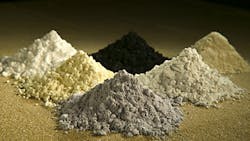Escaping China's Grip on Rare Earths is Key to a U.S. Manufacturing Renaissance
China's hold on the rare earths market is a source of constant frustration for manufacturers of high tech goods. China produces as much as 95% of the world's supply of these elements -- which are critical components of just about every electronic gadget we use today -- giving it unusual control over the global market.
This monopoly has allowed China a heavy influence on the price of such materials through production caps and export quotas. IndustryWeek reported recently that such market manipulations shot the price of one material, dysprosium, up from about $250 per kilogram in 2004 to $1,400 today, after reaching a high of $2,500 last year.
In a world dependent upon high tech gear and with manufacturers scrambling to cut costs wherever they can, the news cycles in recent months have been full of outcry over this artificial supply crisis.
While politicians and global trade organizations cry foul and demand fair shares, Paul Martyn, vice president of supply strategy at BravoSolution, argues that this situation marks a time for manufacturers to break free from China and do what they do best: innovate.
Breaking Free from China
"Dependency on one country or source for rare earths is dangerous," he said. "Right now the situation is fairly dire in the industry because we are being held captive by the Chinese for these materials."
The solution, he said, is to minimize China's role by leveraging our primary assets and investing in local sourcing.
"The gamesmanship China is playing and the critical nature of the supply to energy, to defense and to electronics has really created an environment now where, on a cost of investment or return on investment perspective, we are seeing a lot of equity companies that have really doubled down on mining exercises," he said.
Today, he explained, there are basically five or six mines in the world that are producing the total supply of rare earths, but as many as 30 new sources have been identified globally. At least a dozen of those sources are right here in North America.
"It's vital right now that manufacturers of high tech components be close to the supply of rare earths and have a reliable source of that supply. That's just basic economics," he said.
A Renaissance of American Manufacturing
If just a few of these local mines pay off, he said, the result could be a total resurgence in the industrial backbone of the United States.
The U.S., he said, is primed for such a production boom. Specifically, ramping up rare earth mining locally connects three critical assets we uniquely possess:
- An innovative manufacturing industry with modern capabilities and technologies.
- A supply of rare earth metals to exploit.
- A large of the supply of natural gas, which could potentially make the fueling of both of these operations more cost effective.
"The capabilities, the energy and the supplies are working in favor of a renaissance of American manufacturing," he said. This renaissance will be pitting the U.S. electronics manufacturers against the old industry giants and could really turn the tables on the traditional markets.
"The laggards of innovation in this space -- namely Sony (IW 1000/33) and Nokia (IW 1000/61) -- risk being clipped by a new entrant into that market with improved manufacturing processes that include better equipment, more modern production capabilities and more product innovations," he said.
These past few years of price manipulations by China, he said, has created a trend moving exactly in this direction.
"What we're seeing is companies like Apple (IW 500/14) have begun to go deeper into the supply chain," he said. "We seem to be in an environment at least in the electronics industry where the pendulum for vertical integration is swinging back in favor."
At BravoSolution, he said, he has already seen several electronic manufacturers already investing in equity firms to bring that locally sources rare earth materials element into play.
"Apple, for example, has been dipping deeper and deeper into securing capabilities and supplies for this kind of operation," he said. "They have been using their significant cash reserves to acquire their suppliers."
As the world leader in innovation and high tech design, Apple's venture into the local vertical markets signals to Martyn a definite possibility of a true U.S. manufacturing renaissance.
The Future
"In the next five to 10 years," said Martyn, "manufacturers should be venturing out and looking for additional sources of supply. By looking at additional sources through folks in the equity world and mining industry, you can begin to get a sense of when additional supply may come out."
Like any such innovative endeavor, he said, the key is to hedge.
"Early entrance into the field could shore up this new supply by making an early commitment," he said. "You're absorbing more risk earlier, but it could pay off in big dividends in the new market."
About the Author
Travis M. Hessman
Editor-in-Chief
Travis Hessman is the editor-in-chief and senior content director for IndustryWeek and New Equipment Digest. He began his career as an intern at IndustryWeek in 2001 and later served as IW's technology and innovation editor. Today, he combines his experience as an educator, a writer, and a journalist to help address some of the most significant challenges in the manufacturing industry, with a particular focus on leadership, training, and the technologies of smart manufacturing.
